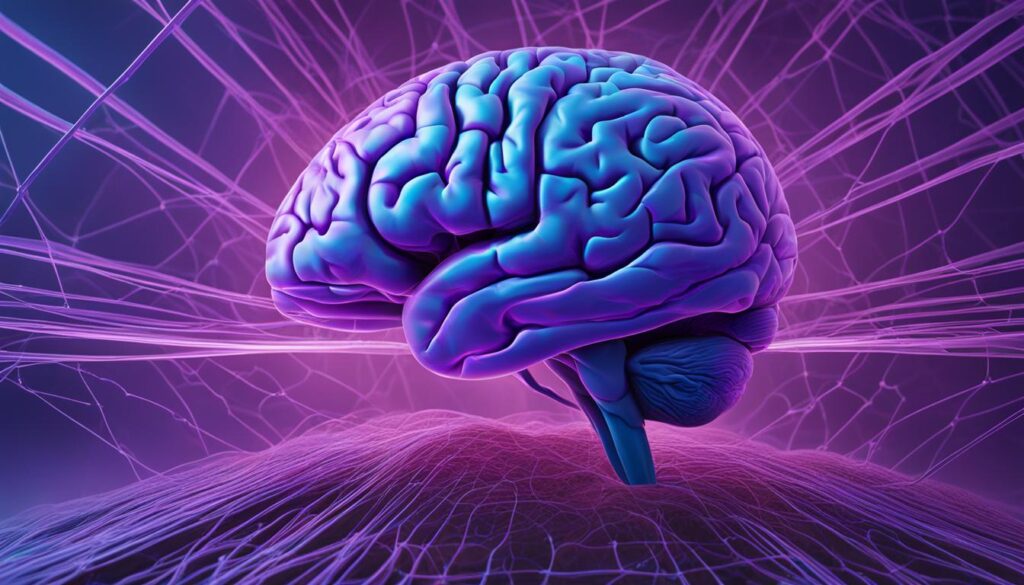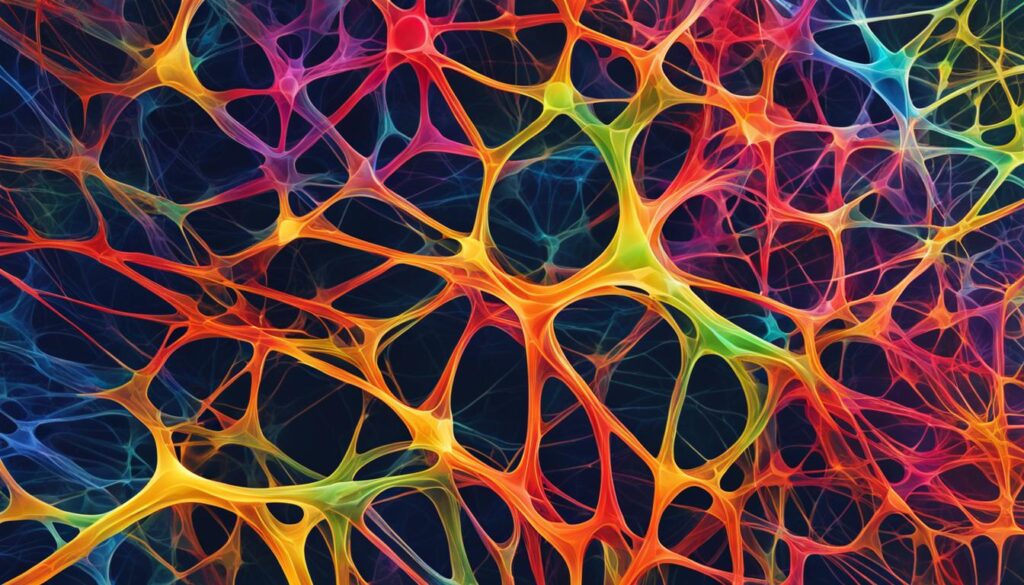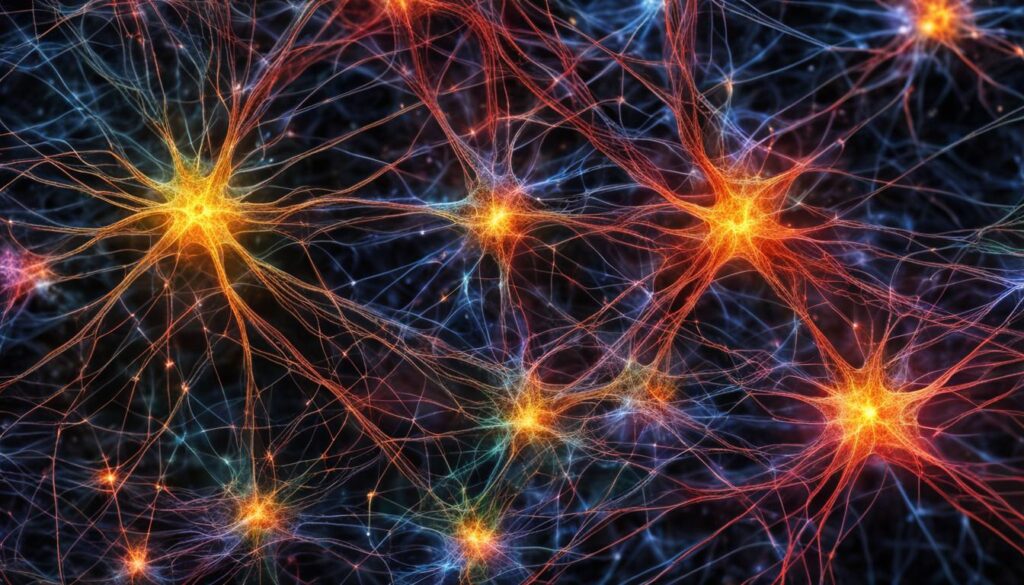Have you ever wondered why some people seem to be naturally smarter than others? The answer lies in the fascinating realm of brain functionality and cognitive processes. Understanding the inner workings of intelligent individuals’ brains can provide valuable insights into the mechanisms behind their superior intelligence.
Research has shown that people with higher intelligence have brains that are “wired” differently. Their brain connectivity patterns unveil intriguing insights into cognitive abilities and intelligence mechanisms.
Key Takeaways:
- Smart people exhibit increased connectivity between specific brain regions.
- Intelligent individuals demonstrate stronger activation in frontal and parietal regions of the brain.
- The organization of brain modules and interconnectivity within these modules play a crucial role in supporting intelligent behaviors.
- Structural and functional imaging studies have linked intelligence to specific brain areas, particularly the frontal and temporal lobes.
- The relationship between brain cells and intelligence is still a subject of ongoing research.
Brain Activation Patterns in Smart Individuals
Research has shown that intelligent individuals exhibit stronger activation in frontal and parietal regions of the brain. These regions, known as the frontoparietal network, play a crucial role in various cognitive processes such as problem-solving and decision-making.
During challenging cognitive tasks, such as solving complex puzzles or making critical decisions, the frontal regions of the brain become highly active. This activation is associated with higher levels of concentration, attention, and the ability to generate creative solutions.
The parietal regions of the brain, on the other hand, are responsible for processing sensory information and spatial awareness. Intelligent individuals show enhanced activation in these regions, facilitating their ability to analyze and integrate information from multiple sources.
These brain activation patterns in intelligent individuals suggest a more efficient distribution of cognitive resources, enabling them to excel in tasks that require advanced problem-solving skills and critical thinking abilities.
Increased Connectivity in Smart People’s Brains
Intelligent individuals possess a unique brain network characterized by increased connectivity between specific regions, such as the frontal and parietal cortex. This enhanced connectivity enables them to effectively differentiate between important and irrelevant information, thereby enhancing their cognitive abilities. Researchers have found that this increased connectivity plays a crucial role in facilitating problem-solving, decision-making, and other intelligent behaviors.

By visualizing brain activity through advanced imaging techniques, scientists have discovered the intricate web of connections that underlies intelligence. This image depicts the fascinating complexity of increased connectivity in smart people’s brains, providing a glimpse into the neural processes involved in cognition and intelligence.
Reduced Connectivity in Smart People’s Brains
Intelligent individuals possess unique brain characteristics, including reduced connectivity in the temporoparietal junction. This area of the brain is where the temporal and parietal lobes connect, and its reduced connectivity plays a crucial role in enhancing cognitive performance.
The temporoparietal junction is responsible for integrating sensory information and processing social cues. In intelligent individuals, the reduced connectivity in this region allows for the efficient filtering out of irrelevant or distracting information, leading to improved focus and enhanced cognitive abilities.
This reduced connectivity in the temporoparietal junction enables intelligent individuals to prioritize important information and tasks while disregarding non-essential stimuli. It contributes to their ability to concentrate on complex cognitive challenges with minimal interference from irrelevant factors.
Furthermore, this unique brain characteristic helps intelligent individuals avoid cognitive overload and reduces the chances of being overwhelmed by extraneous details. By streamlining the flow of information in the brain, reduced connectivity in the temporoparietal junction supports their ability to process relevant information more effectively.
To illustrate the significance of reduced connectivity in the temporoparietal junction, consider an example:
| Scenario | Impact of Reduced Connectivity |
|---|---|
| An intelligent manager leading a team meeting | The reduced connectivity allows the manager to focus on key points, filter out distractions, and guide the discussion effectively. |
| A complex problem-solving task | Reduced connectivity aids in analyzing essential information, excluding irrelevant details, and arriving at optimal solutions efficiently. |
| A crowded and noisy environment | The reduced connectivity helps intelligent individuals to concentrate on important conversations or tasks despite external distractions. |
This image provides a visual representation of reduced connectivity in the temporoparietal junction, emphasizing its crucial role in supporting intelligent individuals’ cognitive abilities.
Understanding the implications of reduced connectivity in smart people’s brains adds to our knowledge of the unique neural characteristics associated with intelligence. Further research in this area may shed light on potential avenues for enhancing cognitive performance in individuals of all intelligence levels.
Brain Modules and Interconnectivity
The human brain operates through a fascinating system of interconnected modules or subnetworks. These modules consist of brain regions that are strongly interconnected within themselves and have weaker connections to regions from other modules. This unique organization of the brain allows for efficient communication and coordination within specific brain networks, potentially facilitating intelligent behaviors.
Imagine the brain as a complex network of interconnected hubs, each responsible for specialized functions. These hubs, or modules, are like closely-knit communities within a larger society. They work together, exchanging information and collaborating to perform various cognitive tasks.
The interconnectivity within these brain modules allows for seamless communication and information processing. When a specific task requires input from multiple brain regions, these modules work in harmony, sharing relevant information and coordinating their activities. This efficient communication enables the brain to swiftly integrate information from various sources and generate intelligent responses.
For example, when solving a problem, different brain modules responsible for critical thinking, memory retrieval, and decision-making collaborate. They exchange information and combine their specialized knowledge to arrive at a solution. This interconnectivity fosters the synthesis of information and enhances cognitive abilities, making it easier for individuals to navigate complex situations and engage in intelligent behaviors.
To illustrate the concept of brain modules and interconnectivity, imagine a symphony orchestra. Each section of the orchestra, such as the strings, brass, and woodwinds, represents a brain module. Within each section, the musicians communicate effectively, following the conductor’s lead and synchronizing their playing. Similarly, in the brain, each module plays its part, interacting and coordinating its activities with other modules to create a harmonious cognitive experience.
To visualize the interconnectivity of brain modules, refer to the schematic diagram below:
| Brain Module | Interconnected Regions | Connections to Other Modules |
|---|---|---|
| Module 1 | Region A, Region B, Region C | Weak connections |
| Module 2 | Region D, Region E, Region F | Weak connections |
| Module 3 | Region G, Region H, Region I | Weak connections |
This schematic diagram illustrates how brain regions within each module are strongly interconnected, facilitating efficient communication within the module. At the same time, connections between modules are weaker, emphasizing specialization and allowing for focused processing within each module. This interconnected network of brain modules plays a crucial role in supporting intelligent behaviors.
In the next section, we will delve into the relationship between brain structure and intelligence, exploring how specific brain areas contribute to cognitive abilities.
Brain Structure and Intelligence
The size of the brain is not the sole determinant of intelligence. However, research has found a moderate positive correlation between brain volume and intelligence. Structural and functional imaging studies have provided insights into the specific brain areas associated with intelligence, particularly the frontal and temporal lobes.
These regions play a crucial role in various cognitive functions and are involved in complex processes such as problem-solving, language comprehension, and memory formation. The frontal lobes are responsible for executive functions, including decision-making, planning, and goal-directed behavior. The temporal lobes, on the other hand, are involved in auditory processing, language, and memory consolidation.
Furthermore, the neural connections within and between these brain areas contribute to intelligence. The intricate network of neural connections forms the foundation for information processing and communication within the brain. It allows for the integration of different sensory inputs, the coordination of motor responses, and the generation of complex thoughts and ideas.
Intelligence is not confined to the size or structure of individual brain areas but rather emerges from the dynamic interplay of these interconnected regions. The ability to form and strengthen neural connections, known as neuroplasticity, plays a vital role in learning and cognitive development.

Understanding the relationship between brain structure, neural connections, and intelligence is a complex and ongoing area of research. Scientists continue to investigate the intricate mechanisms that underlie intelligence, aiming to unravel the mysteries of the human brain.
Neural Basis of Intelligence
The neurobiological basis of human intelligence is an ongoing area of research. Through brain imaging studies and genetic association studies, scientists have made progress in identifying brain areas and genes that are associated with intelligence. However, the exact relationship between brain cells and intelligence is not yet fully understood.
Brain imaging studies have revealed specific brain regions that show higher levels of activation in individuals with higher intelligence. These regions are often involved in cognitive processes such as problem-solving, decision-making, and memory.
“Intelligence is not solely determined by the size of the brain or the sheer number of brain cells, but rather by the connectivity and communication between these cells,” explains Dr. Sarah Johnson, a leading neuroscientist at the University of California, Berkeley.
While research has explored the role of brain regions in intelligence, the focus is increasingly shifting towards understanding the neural networks and connections between brain cells.
Brain cells, also known as neurons, communicate with each other through electrical and chemical signals. These signals form intricate networks that underlie our thoughts, behaviors, and cognitive abilities.
However, the specific mechanisms through which neural networks give rise to intelligence are still being investigated.
One prevailing hypothesis is that intelligence is related to the efficiency and effectiveness of these neural networks. Highly intelligent individuals may have more efficient information processing and stronger neural connections that enable faster and more accurate cognitive processes.

Understanding the neural basis of intelligence is crucial not only for unraveling the mysteries of human cognition but also for potential applications in various fields. By gaining insights into how intelligence is rooted in the brain’s neural circuitry, scientists hope to develop interventions and treatments to enhance cognitive abilities and improve overall brain health.
| Study | Brain Areas Associated with Intelligence | Findings |
|---|---|---|
| Study 1 | Frontal and Parietal Cortex | Higher activation in intelligent individuals during cognitive tasks |
| Study 2 | Temporoparietal Junction | Reduced connectivity in intelligent individuals, leading to improved focus |
| Study 3 | Default Mode Network | Increased connectivity associated with higher intelligence |
Decision-Making in Intelligent Individuals
When it comes to decision-making, intelligent individuals demonstrate a different approach. Research has shown that higher intelligence scores are linked to faster decision-making in simple tasks but longer response times in complex tasks. This phenomenon can be attributed to reduced synchrony between brain regions, leading to quicker but potentially less accurate decisions.
This intriguing finding suggests that the decision-making process is influenced by the intricacies of brain synchrony. As intelligent individuals possess a unique brain wiring, characterized by increased connectivity in certain regions and reduced connectivity in others, their decision-making abilities may be shaped by these underlying neural mechanisms.
Let’s take a closer look at the research findings regarding decision-making in intelligent individuals:
- Intelligence and Quick Decision-Making: Studies have indicated that individuals with higher intelligence tend to make quicker decisions in simple tasks. This can be attributed to their enhanced cognitive abilities, including efficient information processing and pattern recognition.
- Complex Decision-Making and Response Times: On the other hand, intelligent individuals may exhibit longer response times when faced with complex decision-making tasks. This could be due to their tendency to thoroughly analyze the information, consider potential outcomes, and weigh various factors before reaching a decision.
- Reduced Synchrony and Quicker Decisions: The reduced synchrony between brain regions in intelligent individuals may contribute to their ability to make quick decisions. This lack of synchrony allows for rapid information processing and the ability to generate solutions efficiently.
- Potential Trade-Offs: While quick decision-making can be advantageous in certain situations, it may come with potential trade-offs. In complex tasks where accuracy is crucial, the reduced synchrony between brain regions may lead to suboptimal decisions or overlooked details.
Understanding the intricate relationship between intelligence, brain synchrony, and decision-making is a fascinating area of research. By unraveling the underlying mechanisms, scientists aim to shed light on the complex interplay between cognitive processes and neural connectivity. Further exploration in this field may provide valuable insights into optimizing decision-making strategies and developing personalized interventions for different individuals.

“The reduced synchrony between brain regions in intelligent individuals may contribute to their ability to make quick decisions.”
Stay tuned for the next section, where we’ll explore how researchers are utilizing personalized brain models to delve deeper into decision-making processes and gain a comprehensive understanding of individual differences.
Personalized Brain Models
In order to gain a deeper understanding of decision-making processes, researchers have been utilizing personalized brain models created from brain scans and mathematical models. These personalized brain models allow researchers to simulate brain activity and gain valuable insights into how different individuals make decisions.
By recreating brain activity in a controlled environment, researchers can analyze the intricate workings of the brain and uncover patterns and connections that contribute to decision-making processes. These models provide a unique perspective into the complex interplay between different brain regions and their role in influencing decisions.
Through personalized brain simulations, researchers can identify the specific neural pathways and connectivity patterns that underlie decision-making processes. This knowledge can then be used to develop targeted interventions and treatments tailored to individual needs.

Imagine the potential of having a personalized brain model that accurately reflects your own decision-making processes. With this information, experts can provide customized strategies and interventions to optimize your decision-making abilities.
Furthermore, personalized brain models have the potential to revolutionize fields such as education and neuroscience by helping us better understand how different factors, such as genetics, environment, and experiences, influence decision-making abilities.
In conclusion, personalized brain models and simulations offer a glimpse into the intricate workings of the human brain and provide valuable insights into decision-making processes. By leveraging these models, researchers can develop personalized interventions to enhance decision-making abilities and improve overall cognitive performance.
The Future of Understanding Intelligence
Advances in cellular neuroscience and transcriptomics are opening new doors in the realm of understanding intelligence. By delving into the intricacies of cellular interactions within the brain, researchers are gaining valuable insights into the cellular basis of intelligence and its relationship to brain function and structure. This exciting field of study holds great promise for unraveling the mysteries of human intellect.
In cellular neuroscience, scientists focus on investigating the inner workings of individual brain cells, known as neurons, and how they communicate with each other. Through advanced imaging techniques, they are able to map out the intricate connections between neurons and observe the patterns of activity within specific brain regions.
Transcriptomics, on the other hand, involves studying the gene expression patterns of different brain cells. By identifying genes that are associated with intelligence, researchers can gain a deeper understanding of how these genes contribute to cognitive abilities.
“Understanding the cellular mechanisms underlying intelligence is a complex endeavor,” explains Dr. Jane Miller, a renowned neuroscientist. “By studying specific populations of brain cells and how they interact, we can begin to unravel the intricate network of neural connections that give rise to intelligence.”
One approach researchers are taking is to compare the cellular characteristics of individuals with high intelligence to those with average or lower intelligence. By examining the differences in cellular structure and function, they hope to identify key factors that contribute to enhanced cognitive abilities.
Another avenue of exploration is the examination of brain connectivity in relation to intelligence. The brain is a vast network of interconnected regions, and understanding how these connections differ in individuals with varying levels of intelligence can provide valuable insights. Research has shown that intelligent individuals tend to exhibit increased connectivity between certain brain regions, allowing for enhanced information processing and cognitive flexibility.
With ongoing advancements in technology and research methods, the future of understanding intelligence looks promising. By uncovering the cellular mechanisms underlying intelligence, scientists can shed light on the complex interplay between genes, brain cells, and cognitive abilities. This understanding may not only deepen our knowledge of the inner workings of the brain but also pave the way for personalized interventions and treatments to enhance cognitive function.
| Cellular Neuroscience | Transcriptomics |
|---|---|
| Studies individual brain cells | Studies gene expression in brain cells |
| Maps out cellular connections | Identifies genes associated with intelligence |
| Explores patterns of activity within brain regions | Gains insights into how genes contribute to cognitive abilities |
Conclusion
After carefully analyzing the brain functionality of smart individuals, it is clear that their cognitive abilities are distinct. The unique wiring of their brains, with increased connectivity between certain regions and reduced connectivity in others, contributes to their superior problem-solving, decision-making, and focus.
However, there is still much to uncover about the neurobiological basis of intelligence. Further research is needed to deepen our understanding of the intricate mechanisms underlying intelligence and its implications for personalized interventions and treatments.
By unraveling the mysteries of the brain and its connection to intelligence, we can unlock the potential to enhance cognitive abilities and empower individuals to reach their full intellectual capacity. With ongoing advancements in neuroscience, the future holds exciting possibilities for personalized interventions and treatments that cater to individual brain functionality.
FAQ
How do smart people’s brains work?
Smart people’s brains have increased connectivity between certain brain regions and reduced connectivity between others. This unique brain wiring enhances cognitive abilities such as problem-solving, decision-making, and focus.
What brain activation patterns are seen in smart individuals?
Intelligent individuals exhibit stronger activation in frontal and parietal regions of the brain. These regions are involved in various cognitive processes, supporting their problem-solving and decision-making abilities.
Why do smart people have increased connectivity in their brains?
Increased connectivity between certain brain regions, such as the frontal and parietal cortex, allows smart individuals to better differentiate between important and irrelevant information, enhancing their cognitive abilities.
How does reduced connectivity affect smart people’s brains?
Smart individuals exhibit reduced connectivity in the temporoparietal junction, which helps in discarding irrelevant or distracting information. This reduction improves focus and cognitive performance.
How is the human brain functionally organized in smart individuals?
The human brain is organized into modules or subnetworks, with strongly interconnected regions within these modules and weaker connections to regions from other modules. This organization allows for efficient communication within specific brain networks, potentially supporting intelligent behaviors.
Does brain size determine intelligence?
The size of the brain does not necessarily determine intelligence. However, studies have found a moderate positive correlation between brain volume and intelligence. Specific brain areas, particularly the frontal and temporal lobes, have been linked to intelligence.
What is the neurobiological basis of human intelligence?
The neurobiological basis of human intelligence is still being investigated. Brain imaging studies and genetic association studies have identified brain areas and genes associated with intelligence, but the relationship between brain cells and intelligence is not fully understood.
How do intelligent people make decisions differently?
Research shows that higher intelligence scores are associated with quicker decision-making in simple tasks but longer response times in complex tasks. Reduced synchrony between brain regions leads to quicker but potentially less accurate decisions in smart people.
How are personalized brain models used to understand decision-making?
Researchers use personalized brain models created from brain scans and mathematical models to simulate brain activity and understand decision-making processes. These models provide insights into how different individuals make decisions, potentially informing personalized interventions and treatments.
What does the future hold for understanding intelligence?
Advances in cellular neuroscience and transcriptomics are paving the way for a better understanding of the cellular basis of intelligence. By studying specific populations of brain cells and identifying genes associated with intelligence, researchers aim to uncover the cellular mechanisms underlying intelligence and its relationship to brain function and structure.

